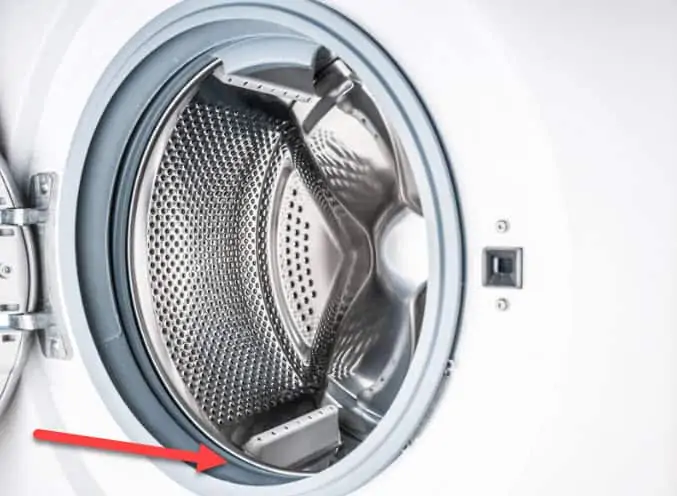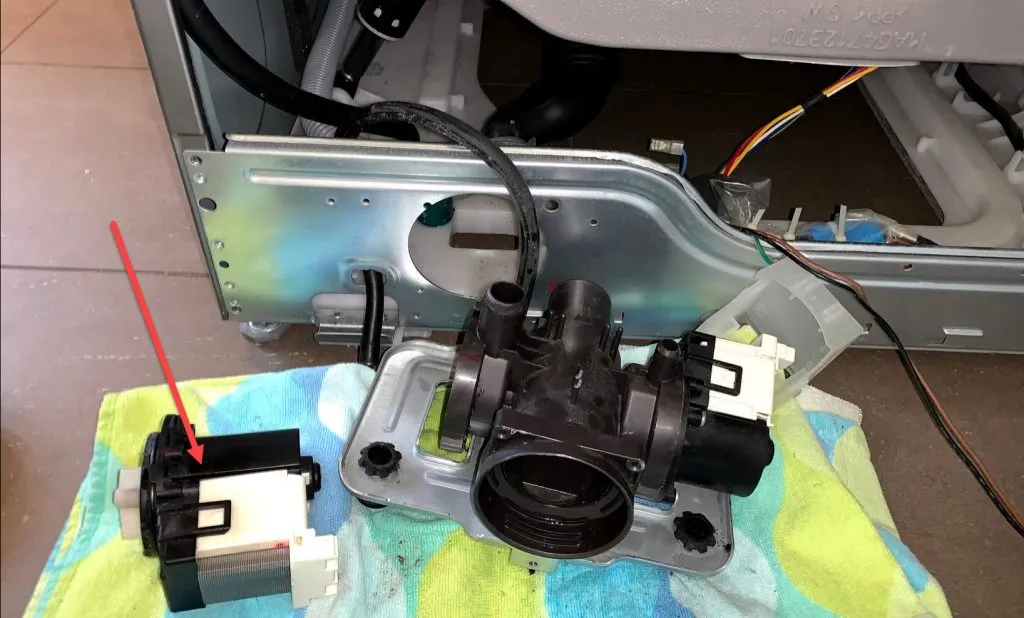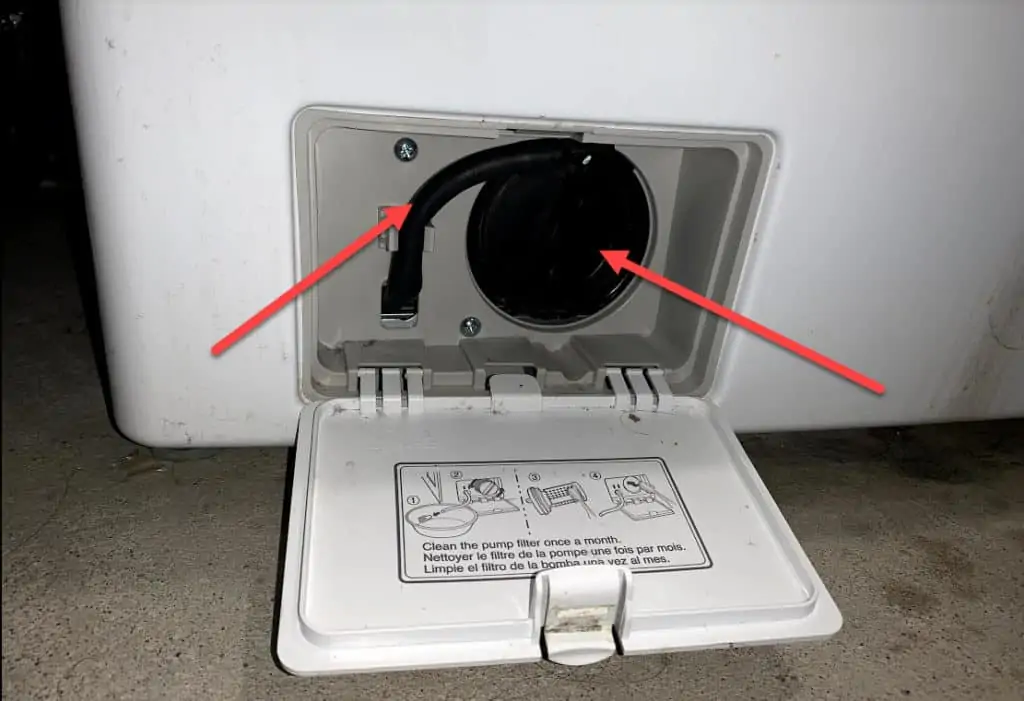Samsung has earned a reputation for manufacturing high-quality household appliances, particularly their innovative washing machines.
However, even the most reliable appliances can occasionally experience issues, and leaks are a common concern for washer owners.
This guide will cover the most common reasons for Samsung washer leaks, categorized by the location of the leak:
- Door Leaks: Problems with the door gasket/seal.
- Underneath Leaks (Top Load): Issues with the drain pump.
- Bottom Filter Leaks: A clogged or improperly installed drain filter.
- Soap Dispenser Leaks: High water pressure or a blocked dispenser hose.
- Back Vent Leaks: Excessive detergent usage.
1) Samsung Washer Is Leaking From Door: Gasket/ Seal

A leaky washer door is a frequent problem.
The culprit is often the door gasket, also known as the door seal.
What it is: The door gasket is a crucial component that creates a watertight seal between the washer door and the machine’s frame.
Typically made of flexible silicone rubber, this circular gasket wraps around the door opening, preventing water from escaping during the wash cycle. Its design ensures a tight, airtight closure.
Why it fails: Several factors can compromise the gasket’s sealing ability.
Foreign objects, like coins, socks, or even detergent buildup, can become lodged between the gasket and the door, disrupting the seal.
Over time, detergent residue can accumulate on the gasket, making it less pliable and effective. Perhaps the most common cause of gasket failure is physical damage.
Sharp objects, such as zippers or buttons, can snag and tear the gasket when removing clothes, creating openings for water to leak.
Here’s How to fix:
- Inspection: Carefully examine the gasket for any visible debris or foreign objects. Remove anything you find.
- Cleaning: Wipe down the entire gasket with a damp cloth to remove detergent residue and grime. A mild detergent solution can be used for stubborn buildup, but be sure to rinse thoroughly.
- Replacement: If the gasket is torn, cracked, or significantly damaged, it must be replaced. Replacement gaskets are readily available online and at appliance parts stores. Consult your washer’s user manual or search online for specific instructions on replacing the gasket for your model. Many online videos can guide you through the process.
2) Samsung Top Load Washing Machine Leaking Water Underneath

For top-load washers, leaks originating from underneath the machine often point to a problem with the drain pump.
What it is: The drain pump is responsible for expelling water from the washer during the drain and spin cycles. It’s typically located at the bottom of the machine.
Why it fails: Over time, the drain pump can become cracked, worn out, or damaged.
This can happen due to normal wear and tear, or from foreign objects becoming lodged in the pump. When the pump is compromised, it may not be able to effectively direct water out through the drain hose, resulting in leaks onto the floor.
How to fix:
- Diagnosis: If water is leaking from underneath your top-load washer, the drain pump is a prime suspect.
- Replacement: A damaged drain pump cannot be repaired and must be replaced. You can purchase a replacement pump online or from appliance parts stores. Ensure you select the correct pump model for your washer.
- Installation: While hiring a technician is an option, replacing the drain pump can be a DIY project for those with some mechanical aptitude. Here’s a general outline:
- Disconnect the power supply to the washer.
- Access the drain pump by removing the appropriate access panel(s).
- Place a container or towels underneath the pump to catch any remaining water.
- Disconnect the hoses and electrical connectors attached to the pump.
- Remove the old pump and install the new one, reconnecting the hoses and electrical connectors in the reverse order.
- Reassemble the access panels.
- Test the washer to ensure the leak is resolved.
3) Samsung Washer Leaking From Drain Filter

Sometimes, a leak that appears to be coming from the bottom of the washer is actually originating from the drain filter.
What it is: The drain filter, usually located behind a small access panel at the front of the washer, is designed to trap debris and prevent it from clogging the drain pump.
Why it fails: The drain filter housing can leak if the filter is not properly installed, is clogged, or if the housing itself is damaged.
If the filter isn’t screwed in tightly enough after cleaning, or if debris buildup prevents a proper seal, water can leak out.
How to fix:
- Access: Locate the access panel for the drain filter and open it.
- Removal and Cleaning: Remove the filter and thoroughly clean it, removing any debris or buildup. Inspect the filter housing for any blockages as well.
- Reinstallation: Reinsert the filter, ensuring it is properly oriented and screwed in tightly to create a secure seal. Close the access panel.
4) Samsung Washer Leaking Water From Soap Dispenser
Leaks from the soap dispenser are often more noticeable than other types of leaks.
What it is: The soap dispenser is where you add detergent and fabric softener. Water flows through the dispenser to mix with these products before entering the drum.
Why it fails: Leaks from the soap dispenser can be caused by excessive water pressure or a blockage in the dispenser hose.
If the incoming water pressure is too high, the dispenser may not be able to handle the flow, resulting in water spraying out. A clogged dispenser hose, often caused by detergent buildup, can also force water to overflow.
How to fix:
- Water Pressure Adjustment: If high water pressure is the issue, slightly turn down the water supply valves connected to your washer. Observe the dispenser during a fill cycle to find the optimal pressure that prevents leaks.
- Clog Removal: If a clog is suspected, you may be able to clear it manually. Consult your washer’s manual for instructions on accessing and cleaning the dispenser hose. A small brush or pipe cleaner may be helpful. For stubborn clogs, you can try pouring hot water through the dispenser to help dissolve detergent buildup. In some cases, disassembling the dispenser may be necessary for thorough cleaning.
5) Samsung Washer Leaking From The Back Vent
While less common, leaks from the back vent of the washer can also occur, often due to excessive detergent usage.
What it is: Samsung washers have a Safety Air Vent, similar to those found on other appliances. This vent helps regulate airflow and pressure within the machine.
Why it fails: Overusing detergent can lead to a buildup of suds and residue inside the washer.
These suds can sometimes escape through the back vent, causing a leak.
How to fix:
- Detergent Dilution: The key to resolving this issue is to dilute and remove the detergent residue.
- Self-Cleaning Cycle: Many Samsung washers have a self-cleaning cycle designed for this purpose. Run this cycle according to the manufacturer’s instructions.
- Manual Cleaning: If your washer doesn’t have a self-cleaning cycle, you can run an empty wash cycle with hot water to help flush out the residue. Repeat as necessary.
- Detergent Usage: Going forward, use the recommended amount of detergent to prevent future buildup and leaks.
Conclusion
Samsung washing machines are known for their quality and performance.
But regular maintenance, such as cleaning the drain filter and using the correct amount of detergent, can also help prevent leaks and prolong the life of your washing machine.

Abdul Kader, a handy guy and experienced founder of a TV repair shop in Gulshan, Dhaka, Bangladesh. He is mainly an expert in understanding and repairing different types of issues with Smart TVs and providing helpful insights on how to keep them in good working order. Read his Full Story.
